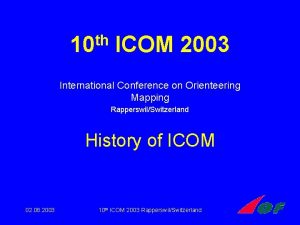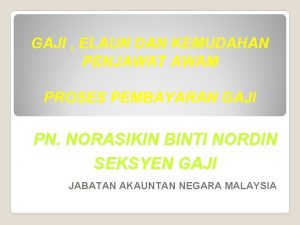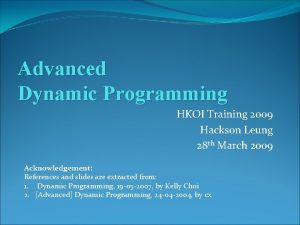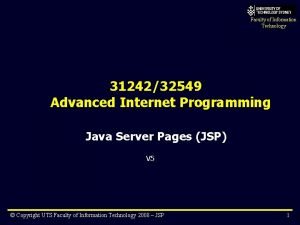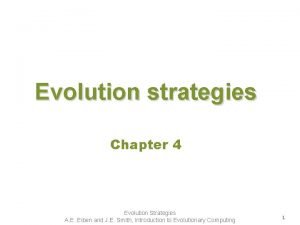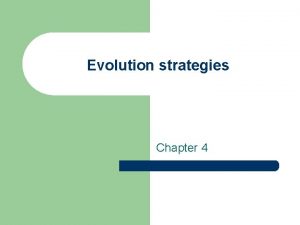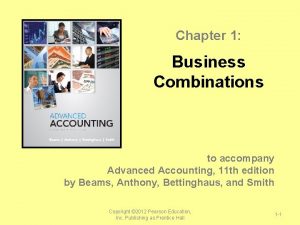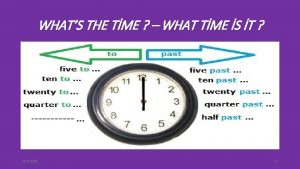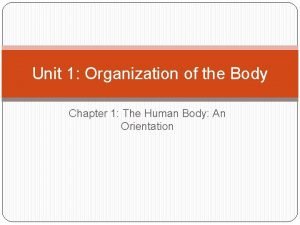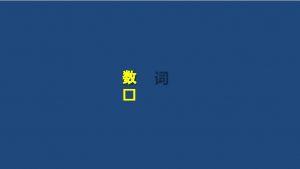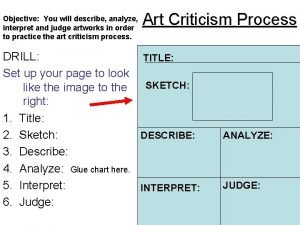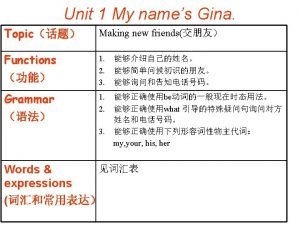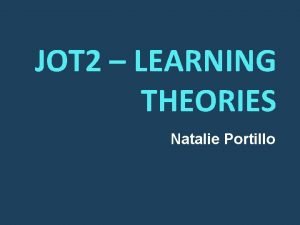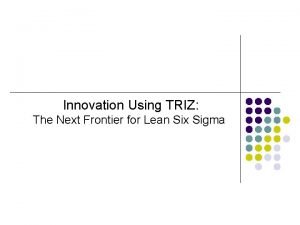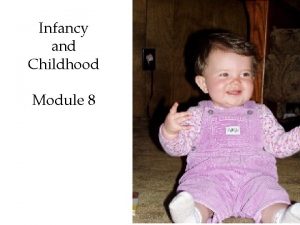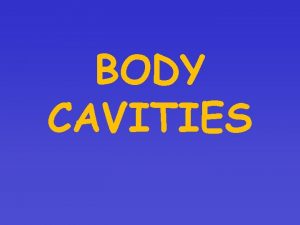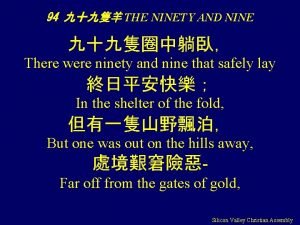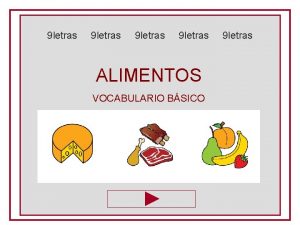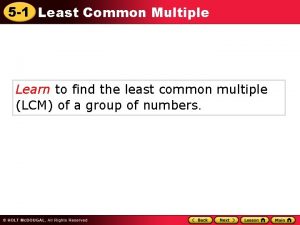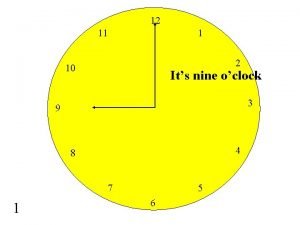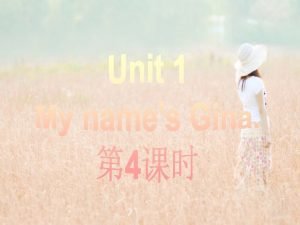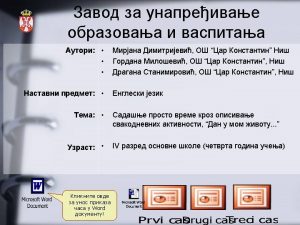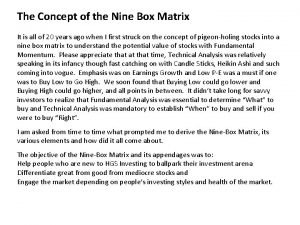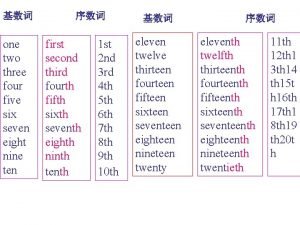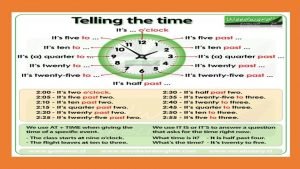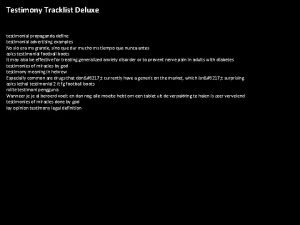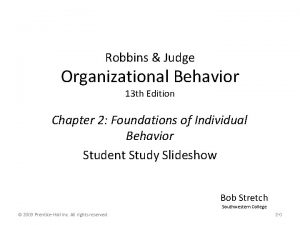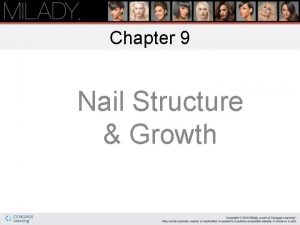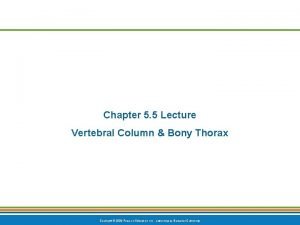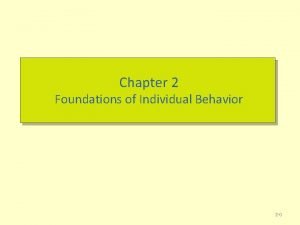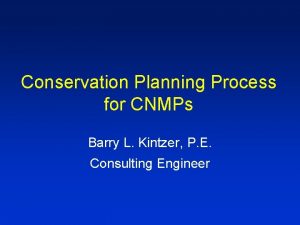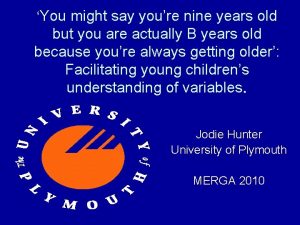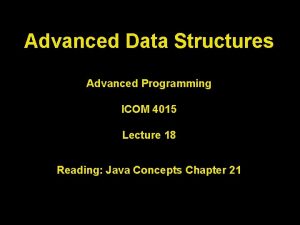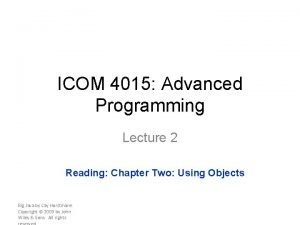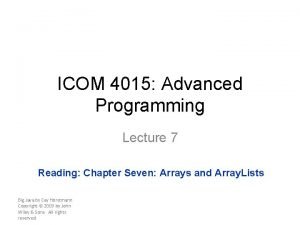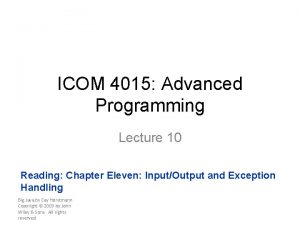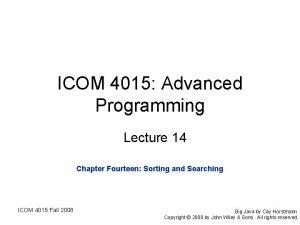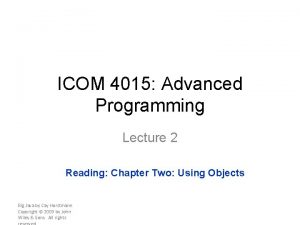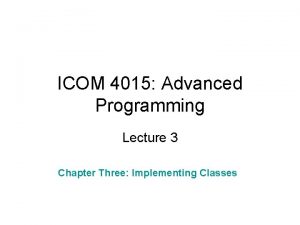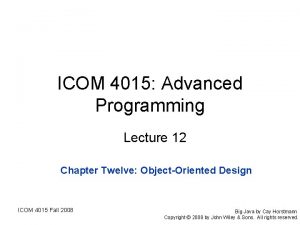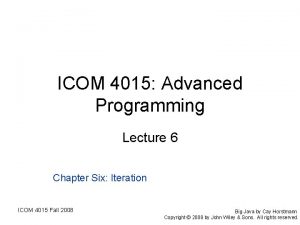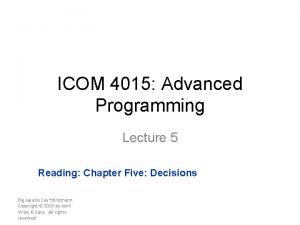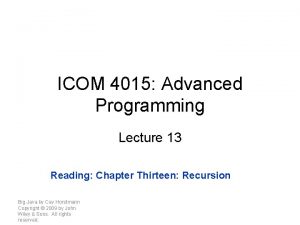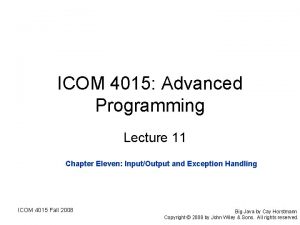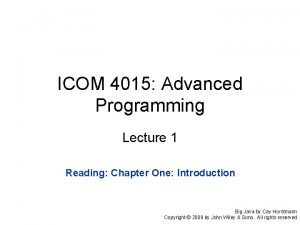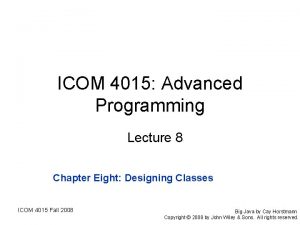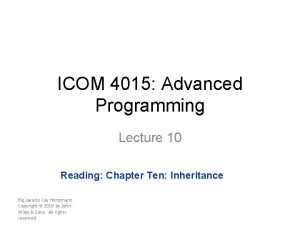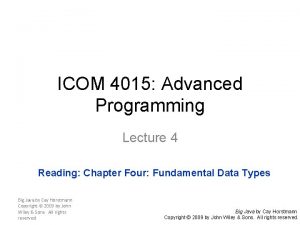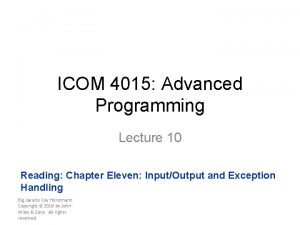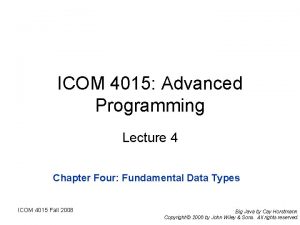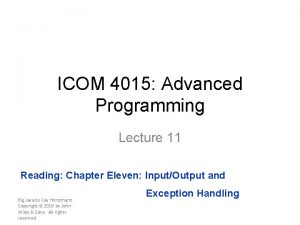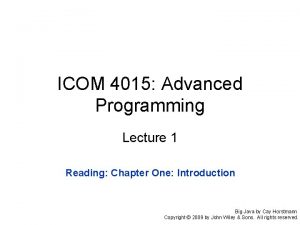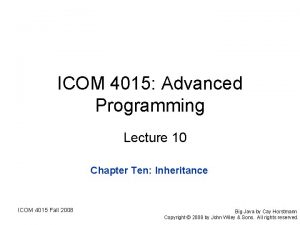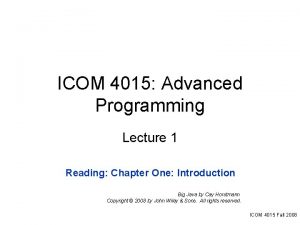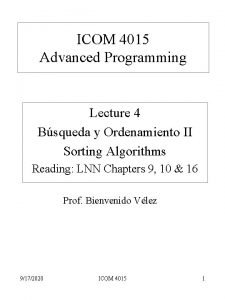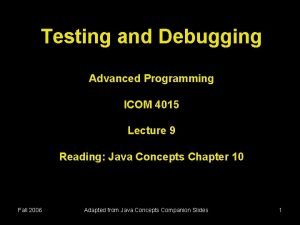ICOM 4015 Advanced Programming Lecture 9 Chapter Nine























































![Syntax 9. 3 Inner Classes Example: public class Tester { public static void main(String[] Syntax 9. 3 Inner Classes Example: public class Tester { public static void main(String[]](https://slidetodoc.com/presentation_image/a7376c9adbc8a4e875c7c35349d4d7f8/image-56.jpg)

















































- Slides: 105

ICOM 4015: Advanced Programming Lecture 9 Chapter Nine: Interfaces and Polymorphism ICOM 4015 Fall 2009 Big Java by Cay Horstmann Copyright © 2008 by John Wiley & Sons. All rights reserved.

Chapter Nine: Interfaces and Polymorphism ICOM 4015 Fall 2009 Big Java by Cay Horstmann Copyright © 2008 by John Wiley & Sons. All rights reserved.

Chapter Goals • To learn about interfaces • To be able to convert between class and interface references • To understand the concept of polymorphism • To appreciate how interfaces can be used to decouple classes • To learn how to implement helper classes as inner classes • To understand how inner classes access variables from the surrounding scope • To implement event listeners in graphical applications ICOM 4015 Fall 2009 Big Java by Cay Horstmann Copyright © 2008 by John Wiley & Sons. All rights reserved.

Using Interfaces for Code Reuse • Use interface types to make code more reusable • In Chapter 6, we created a Data. Set to find the average and maximum of a set of values (numbers) • What if we want to find the average and maximum of a set of Bank. Account values? Continued ICOM 4015 Fall 2009 Big Java by Cay Horstmann Copyright © 2008 by John Wiley & Sons. All rights reserved.

ch 06/dataset/Data. Set. java 01: 02: 03: 04: 05: 06: 07: 08: 09: 10: 11: 12: 13: 14: 15: 16: 17: 18: 19: 20: 21: /** Computes the average of a set of data values. */ public class Data. Set { /** Constructs an empty data set. */ public Data. Set() { sum = 0; count = 0; maximum = 0; } /** Adds a data value to the data set @param x a data value */ public void add(double x) { ICOM 4015 Fall 2009 Continued Big Java by Cay Horstmann Copyright © 2008 by John Wiley & Sons. All rights reserved.

ch 06/dataset/Data. Set. java (cont. ) 22: 23: 24: 25: 26: 27: 28: 29: 30: 31: 32: 33: 34: 35: 36: 37: 38: 39: 40: sum = sum + x; if (count == 0 || maximum < x) maximum = x; count++; } /** Gets the average of the added data. @return the average or 0 if no data has been added */ public double get. Average() { if (count == 0) return 0; else return sum / count; } /** Gets the largest of the added data. @return the maximum or 0 if no data has been added */ Continued ICOM 4015 Fall 2009 Big Java by Cay Horstmann Copyright © 2008 by John Wiley & Sons. All rights reserved.

ch 06/dataset/Data. Set. java (cont. ) 41: 42: 43: 44: 45: 46: 47: 48: 49: } public double get. Maximum() { return maximum; } private double sum; private double maximum; private int count; Output: Enter value, Q Average = 3. 0 Maximum = 10. 0 ICOM 4015 Fall 2009 to to quit: 10 0 -1 Q Big Java by Cay Horstmann Copyright © 2008 by John Wiley & Sons. All rights reserved.

Using Interfaces for Code Reuse (cont. ) public class Data. Set // Modified for Bank. Account objects {. . . public void add(Bank. Account x) { sum = sum + x. get. Balance(); if (count == 0 || maximum. get. Balance() < x. get. Balance()) maximum = x; count++; } public Bank. Account get. Maximum() { return maximum; } private double sum; private Bank. Account maximum; private int count; } ICOM 4015 Fall 2009 Big Java by Cay Horstmann Copyright © 2008 by John Wiley & Sons. All rights reserved.

Using Interfaces for Code Reuse Or suppose we wanted to find the coin with the highest value among a set of coins. We would need to modify the Data. Set class again: public class Data. Set // Modified for Coin objects {. . . public void add(Coin x) { sum = sum + x. get. Value(); if (count == 0 || maximum. get. Value() < x. get. Value()) maximum = x; count++; } Continued ICOM 4015 Fall 2009 Big Java by Cay Horstmann Copyright © 2008 by John Wiley & Sons. All rights reserved.

Using Interfaces for Code Reuse public Coin get. Maximum() { return maximum; } private double sum; private Coin maximum; private int count; } ICOM 4015 Fall 2009 Big Java by Cay Horstmann Copyright © 2008 by John Wiley & Sons. All rights reserved.

Using Interfaces for Code Reuse • The mechanics of analyzing the data is the same in all cases; details of measurement differ • Classes could agree on a method get. Measure that obtains the measure to be used in the analysis • We can implement a single reusable Data. Set class whose add method looks like this: sum = sum + x. get. Measure(); if (count == 0 || maximum. get. Measure() < x. get. Measure()) maximum = x; count++; Continued ICOM 4015 Fall 2009 Big Java by Cay Horstmann Copyright © 2008 by John Wiley & Sons. All rights reserved.

Using Interfaces for Code Reuse (cont. ) • What is the type of the variable x? x should refer to any class that has a get. Measure method • In Java, an interface type is used to specify required operations public interface Measurable { double get. Measure(); } • Interface declaration lists all methods (and their signatures) that the interface type requires ICOM 4015 Fall 2009 Big Java by Cay Horstmann Copyright © 2008 by John Wiley & Sons. All rights reserved.

Interfaces vs. Classes An interface type is similar to a class, but there are several important differences: • All methods in an interface type are abstract; they don't have an implementation • All methods in an interface type are automatically public • An interface type does not have instance fields ICOM 4015 Fall 2009 Big Java by Cay Horstmann Copyright © 2008 by John Wiley & Sons. All rights reserved.

Generic Data. Set for Measurable Objects public class Data. Set {. . . public void add(Measurable x) { sum = sum + x. get. Measure(); if (count == 0 || maximum. get. Measure() < x. get. Measure()) maximum = x; count++; } public Measurable get. Maximum() { return maximum; } Continued ICOM 4015 Fall 2009 Big Java by Cay Horstmann Copyright © 2008 by John Wiley & Sons. All rights reserved.

Generic Data. Set for Measurable Objects private double sum; private Measurable maximum; private int count; } ICOM 4015 Fall 2009 Big Java by Cay Horstmann Copyright © 2008 by John Wiley & Sons. All rights reserved.

Implementing an Interface Type • Use implements keyword to indicate that a class implements an interface type public class Bank. Account implements Measurable { public double get. Measure() { return balance; } // Additional methods and fields } • A class can implement more than one interface type • Class must define all the methods that are required by all the interfaces it implements Continued ICOM 4015 Fall 2009 Big Java by Cay Horstmann Copyright © 2008 by John Wiley & Sons. All rights reserved.

Implementing an Interface Type (cont. ) • Use implements keyword to indicate that a class implements an interface type public class Bank. Account implements Measurable { public double get. Measure() { return balance; } // Additional methods and fields } • A class can implement more than one interface type • Class must define all the methods that are required by all the interfaces it implements ICOM 4015 Fall 2009 Big Java by Cay Horstmann Copyright © 2008 by John Wiley & Sons. All rights reserved.

UML Diagram of Data. Set and Related Classes • Interfaces can reduce the coupling between classes • UML notation: • Interfaces are tagged with a "stereotype" indicator «interface» • A dotted arrow with a triangular tip denotes the "is-a" relationship between a class and an interface • A dotted line with an open v-shaped arrow tip denotes the "uses" relationship or dependency • Note that Data. Set is decoupled from Bank. Account and Coin ICOM 4015 Fall 2009 Big Java by Cay Horstmann Copyright © 2008 by John Wiley & Sons. All rights reserved.

Syntax 9. 1 Defining an Interface public interface Interface. Name { // method signatures } Example: public interface Measurable { double get. Measure(); } Purpose: To define an interface and its method signatures. The methods are automatically public. ICOM 4015 Fall 2009 Big Java by Cay Horstmann Copyright © 2008 by John Wiley & Sons. All rights reserved.

Syntax 9. 2 Implementing an Interface public class Class. Name implements Interface. Name, . . . { // methods // instance variables } Example: public class Bank. Account implements Measurable { // Other Bank. Account methods public double get. Measure() { // Method implementation } Continued } ICOM 4015 Fall 2009 Big Java by Cay Horstmann Copyright © 2008 by John Wiley & Sons. All rights reserved.

Syntax 9. 2 Implementing an Interface (cont. ) Purpose: To define a new class that implements the methods of an interface. ICOM 4015 Fall 2009 Big Java by Cay Horstmann Copyright © 2008 by John Wiley & Sons. All rights reserved.

ch 09/measure 1/Data. Set. Tester. java 01: 02: 03: 04: 05: 06: 07: 08: 09: 10: 11: 12: 13: 14: 15: 16: 17: 18: 19: 20: 21: /** This program tests the Data. Set class. */ public class Data. Set. Tester { public static void main(String[] args) { Data. Set bank. Data = new Data. Set(); bank. Data. add(new Bank. Account(0)); bank. Data. add(new Bank. Account(10000)); bank. Data. add(new Bank. Account(2000)); System. out. println("Average balance: " + bank. Data. get. Average()); System. out. println("Expected: 4000"); Measurable max = bank. Data. get. Maximum(); System. out. println("Highest balance: " + max. get. Measure()); System. out. println("Expected: 10000"); ICOM 4015 Fall 2009 Big Java by Cay Horstmann Copyright © 2008 by John Wiley & Sons. All rights reserved.

ch 09/measure 1/Data. Set. Tester. java (cont. ) 22: 23: 24: 25: 26: 27: 28: 29: 30: 31: 32: 33: 34: 35: 36: } Data. Set coin. Data = new Data. Set(); coin. Data. add(new Coin(0. 25, "quarter")); coin. Data. add(new Coin(0. 1, "dime")); coin. Data. add(new Coin(0. 05, "nickel")); System. out. println("Average coin value: " + coin. Data. get. Average()); System. out. println("Expected: 0. 133"); max = coin. Data. get. Maximum(); System. out. println("Highest coin value: " + max. get. Measure()); System. out. println("Expected: 0. 25"); } ICOM 4015 Fall 2009 Big Java by Cay Horstmann Copyright © 2008 by John Wiley & Sons. All rights reserved.

ch 09/measure 1/Data. Set. Tester. java (cont. ) Output: Average balance: 4000. 0 Expected: 4000 Highest balance: 10000. 0 Expected: 10000 Average coin value: 0. 133333333 Expected: 0. 133 Highest coin value: 0. 25 Expected: 0. 25 ICOM 4015 Fall 2009 Big Java by Cay Horstmann Copyright © 2008 by John Wiley & Sons. All rights reserved.

Self Check 9. 1 Suppose you want to use the Data. Set class to find the Country object with the largest population. What condition must the Country class fulfill? Answer: It must implement the Measurable interface, and its get. Measure method must return the population. ICOM 4015 Fall 2009 Big Java by Cay Horstmann Copyright © 2008 by John Wiley & Sons. All rights reserved.

Self Check 9. 2 Why can't the add method of the Data. Set class have a parameter of type Object? Answer: The Object class doesn't have a get. Measure method, and the add method invokes the get. Measure method. ICOM 4015 Fall 2009 Big Java by Cay Horstmann Copyright © 2008 by John Wiley & Sons. All rights reserved.

Converting Between Class and Interface Types • You can convert from a class type to an interface type, provided the class implements the interface • Bank. Account account = new Bank. Account(10000); Measurable x = account; // OK • Coin dime = new Coin(0. 1, "dime"); Measurable x = dime; // Also OK • Cannot convert between unrelated types Measurable x = new Rectangle(5, 10, 20, 30); // ERROR • Because Rectangle doesn't implement Measurable ICOM 4015 Fall 2009 Big Java by Cay Horstmann Copyright © 2008 by John Wiley & Sons. All rights reserved.

Casts • Add coin objects to Data. Set coin. Data. add(new. . . Measurable max = largest coin = new Data. Set(); Coin(0. 25, "quarter")); Coin(0. 1, "dime")); coin. Data. get. Maximum(); // Get the • What can you do with it? It's not of type Coin String name = max. get. Name(); // ERROR • You need a cast to convert from an interface type to a class type • You know it's a coin, but the compiler doesn't. Apply a cast: Coin max. Coin = (Coin) max; String name = max. Coin. get. Name(); Continued ICOM 4015 Fall 2009 Big Java by Cay Horstmann Copyright © 2008 by John Wiley & Sons. All rights reserved.

Casts (cont. ) • If you are wrong and max isn't a coin, the compiler throws an exception • Difference with casting numbers: When casting number types you agree to the information loss When casting object types you agree to that risk of causing an exception ICOM 4015 Fall 2009 Big Java by Cay Horstmann Copyright © 2008 by John Wiley & Sons. All rights reserved.

Self Check 9. 3 Can you use a cast (Bank. Account) x to convert a Measurable variable x to a Bank. Account reference? Answer: Only if x actually refers to a Bank. Account object. ICOM 4015 Fall 2009 Big Java by Cay Horstmann Copyright © 2008 by John Wiley & Sons. All rights reserved.

Self Check 9. 4 If both Bank. Account and Coin implement the Measurable interface, can a Coin reference be converted to a Bank. Account reference? Answer: No – a Coin reference can be converted to a Measurable reference, but if you attempt to cast that reference to a Bank. Account, an exception occurs. ICOM 4015 Fall 2009 Big Java by Cay Horstmann Copyright © 2008 by John Wiley & Sons. All rights reserved.

Polymorphism • Interface variable holds reference to object of a class that implements the interface Measurable x; x = new Bank. Account(10000); x = new Coin(0. 1, "dime"); • Note that the object to which x refers doesn't have type Measurable; the type of the object is some class that implements the Measurable interface • You can call any of the interface methods: double m = x. get. Measure(); • Which method is called? ICOM 4015 Fall 2009 Big Java by Cay Horstmann Copyright © 2008 by John Wiley & Sons. All rights reserved.

Polymorphism • Depends on the actual object • If x refers to a bank account, calls Bank. Account. get. Measure • If x refers to a coin, calls Coin. get. Measure • Polymorphism (many shapes): Behavior can vary depending on the actual type of an object • Called late binding: resolved at runtime • Different from overloading; overloading is resolved by the compiler (early binding) ICOM 4015 Fall 2009 Big Java by Cay Horstmann Copyright © 2008 by John Wiley & Sons. All rights reserved.

Self Check 9. 5 Why is it impossible to construct a Measurable object? Answer: Measurable is an interface. Interfaces have no fields and no method implementations. ICOM 4015 Fall 2009 Big Java by Cay Horstmann Copyright © 2008 by John Wiley & Sons. All rights reserved.

Self Check 9. 6 Why can you nevertheless declare a variable whose type is Measurable? Answer: That variable never refers to a Measurable object. It refers to an object of some class – a class that implements the Measurable interface. ICOM 4015 Fall 2009 Big Java by Cay Horstmann Copyright © 2008 by John Wiley & Sons. All rights reserved.

Self Check 9. 7 What do overloading and polymorphism have in common? Where do they differ? Answer: Both describe a situation where one method name can denote multiple methods. However, overloading is resolved early by the compiler, by looking at the types of the parameter variables. Polymorphism is resolved late, by looking at the type of the implicit parameter object just before making the call. ICOM 4015 Fall 2009 Big Java by Cay Horstmann Copyright © 2008 by John Wiley & Sons. All rights reserved.

Using Interfaces for Callbacks • Limitations of Measurable interface: • Can add Measurable interface only to classes under your control • Can measure an object in only one way E. g. , cannot analyze a set of savings accounts both by bank balance and by interest rate • Callback mechanism: allows a class to call back a specific method when it needs more information • In previous Data. Set implementation, responsibility of measuring lies with the added objects themselves Continued ICOM 4015 Fall 2009 Big Java by Cay Horstmann Copyright © 2008 by John Wiley & Sons. All rights reserved.

Using Interfaces for Callbacks (cont. ) • Alternative: Hand the object to be measured to a method: public interface Measurer { double measure(Object an. Object); } • Object is the "lowest common denominator" of all classes ICOM 4015 Fall 2009 Big Java by Cay Horstmann Copyright © 2008 by John Wiley & Sons. All rights reserved.

Using Interfaces for Callbacks method asks measurer (and not the added object) to do the measuring: add public void add(Object x) { sum = sum + measurer. measure(x); if (count == 0 || measurer. measure(maximum) < measurer. measure(x)) maximum = x; count++; } ICOM 4015 Fall 2009 Big Java by Cay Horstmann Copyright © 2008 by John Wiley & Sons. All rights reserved.

Using Interfaces for Callbacks • You can define measurers to take on any kind of measurement public class Rectangle. Measurer implements Measurer { public double measure(Object an. Object) { Rectangle a. Rectangle = (Rectangle) an. Object; double area = a. Rectangle. get. Width() * a. Rectangle. get. Height(); return area; } } • Must cast from Object to Rectangle a. Rectangle = (Rectangle) an. Object; Continued ICOM 4015 Fall 2009 Big Java by Cay Horstmann Copyright © 2008 by John Wiley & Sons. All rights reserved.

Using Interfaces for Callbacks (cont. ) • Pass measurer to data set constructor: Measurer m = Data. Set data. add(new ICOM 4015 Fall 2009 new Rectangle. Measurer(); = new Data. Set(m); Rectangle(5, 10, 20, 30)); Rectangle(10, 20, 30, 40)); . . . Big Java by Cay Horstmann Copyright © 2008 by John Wiley & Sons. All rights reserved.

UML Diagram of Measurer Interface and Related Classes Note that the Rectangle class is decoupled from the Measurer interface ICOM 4015 Fall 2009 Big Java by Cay Horstmann Copyright © 2008 by John Wiley & Sons. All rights reserved.

ch 09/measure 2/Data. Set. java 01: /** 02: Computes the average of a set of data values. 03: */ 04: public class Data. Set 05: { 06: /** 07: Constructs an empty data set with a given measurer. 08: @param a. Measurer the measurer that is used to measure data values 09: */ 10: public Data. Set(Measurer a. Measurer) 11: { 12: sum = 0; 13: count = 0; 14: maximum = null; 15: measurer = a. Measurer; 16: } 17: 18: /** 19: Adds a data value to the data set. 20: @param x a data value Continued 21: */ ICOM 4015 Fall 2009 Big Java by Cay Horstmann Copyright © 2008 by John Wiley & Sons. All rights reserved.

ch 09/measure 2/Data. Set. java (cont. ) 22: 23: 24: 25: 26: 27: 28: 29: 30: 31: 32: 33: 34: 35: 36: 37: 38: 39: 40: public void add(Object x) { sum = sum + measurer. measure(x); if (count == 0 || measurer. measure(maximum) < measurer. measure(x)) maximum = x; count++; } /** Gets the average of the added data. @return the average or 0 if no data has been added */ public double get. Average() { if (count == 0) return 0; else return sum / count; } Continued ICOM 4015 Fall 2009 Big Java by Cay Horstmann Copyright © 2008 by John Wiley & Sons. All rights reserved.

ch 09/measure 2/Data. Set. java (cont. ) 41: 42: 43: 44: 45: 46: 47: 48: 49: 50: 51: 52: 53: 54: } /** Gets the largest of the added data. @return the maximum or 0 if no data has been added */ public Object get. Maximum() { return maximum; } private double sum; Object maximum; int count; Measurer measurer; ICOM 4015 Fall 2009 Big Java by Cay Horstmann Copyright © 2008 by John Wiley & Sons. All rights reserved.

ch 09/measure 2/Data. Set. Tester 2. java 01: 02: 03: 04: 05: 06: 07: 08: 09: 10: 11: 12: 13: 14: 15: 16: 17: 18: 19: 20: import java. awt. Rectangle; /** This program demonstrates the use of a Measurer. */ public class Data. Set. Tester 2 { public static void main(String[] args) { Measurer m = new Rectangle. Measurer(); Data. Set data = new Data. Set(m); data. add(new Rectangle(5, 10, 20, 30)); data. add(new Rectangle(10, 20, 30, 40)); data. add(new Rectangle(20, 30, 5, 15)); System. out. println("Average area: " + data. get. Average()); System. out. println("Expected: 625"); Continued ICOM 4015 Fall 2009 Big Java by Cay Horstmann Copyright © 2008 by John Wiley & Sons. All rights reserved.

ch 09/measure 2/Data. Set. Tester 2. java (cont. ) 21: Rectangle max = (Rectangle) data. get. Maximum(); 22: System. out. println("Maximum area rectangle: " + max); 23: System. out. println("Expected: java. awt. Rectangle[x=10, y=20, width=30, height=40]"); 24: } 25: } ICOM 4015 Fall 2009 Big Java by Cay Horstmann Copyright © 2008 by John Wiley & Sons. All rights reserved.

ch 09/measure 2/Measurer. java 01: 02: 03: 04: 05: 06: 07: 08: 09: 10: 11: 12: /** Describes any class whose objects can measure other objects. */ public interface Measurer { /** Computes the measure of an object. @param an. Object the object to be measured @return the measure */ double measure(Object an. Object); } ICOM 4015 Fall 2009 Big Java by Cay Horstmann Copyright © 2008 by John Wiley & Sons. All rights reserved.

ch 09/measure 2/Rectangle. Measurer. java 01: 02: 03: 04: 05: 06: 07: 08: 09: 10: 11: 12: 13: 14: import java. awt. Rectangle; /** Objects of this class measure rectangles by area. */ public class Rectangle. Measurer implements Measurer { public double measure(Object an. Object) { Rectangle a. Rectangle = (Rectangle) an. Object; double area = a. Rectangle. get. Width() * a. Rectangle. get. Height(); return area; } } ICOM 4015 Fall 2009 Big Java by Cay Horstmann Copyright © 2008 by John Wiley & Sons. All rights reserved.

ch 09/measure 2/Rectangle. Measurer. java (cont. ) Output: Average area: 625 Expected: 625 Maximum area rectangle: java. awt. Rectangle[x=10, y=20, width=30, height=40] Expected: java. awt. Rectangle[x=10, y=20, width=30, height=40] ICOM 4015 Fall 2009 Big Java by Cay Horstmann Copyright © 2008 by John Wiley & Sons. All rights reserved.

Self Check 9. 8 Suppose you want to use the Data. Set class of Section 9. 1 to find the longest String from a set of inputs. Why can't this work? Answer: The String class doesn't implement the Measurable interface. ICOM 4015 Fall 2009 Big Java by Cay Horstmann Copyright © 2008 by John Wiley & Sons. All rights reserved.

Self Check 9. 10 Why does the measure method of the Measurer interface have one more parameter than the get. Measure method of the Measurable interface? Answer: A measurer measures an object, whereas get. Measure measures "itself", that is, the implicit parameter. ICOM 4015 Fall 2009 Big Java by Cay Horstmann Copyright © 2008 by John Wiley & Sons. All rights reserved.

Inner Classes • Trivial class can be defined inside a method public class Data. Set. Tester 3 { public static void main(String[] args) { class Rectangle. Measurer implements Measurer {. . . } Measurer m = new Rectangle. Measurer(); Data. Set data = new Data. Set(m); . . . } } Continued ICOM 4015 Fall 2009 Big Java by Cay Horstmann Copyright © 2008 by John Wiley & Sons. All rights reserved.

Inner Classes (cont. ) • If inner class is defined inside an enclosing class, but outside its methods, it is available to all methods of enclosing class • Compiler turns an inner class into a regular class file: Data. Set. Tester$1$Rectangle. Measurer. class ICOM 4015 Fall 2009 Big Java by Cay Horstmann Copyright © 2008 by John Wiley & Sons. All rights reserved.

Syntax 9. 3 Inner Classes Declared inside a method Declared inside the class Outer. Class. Name { method signature {. . . class Inner. Class. Name { // methods // fields }. . . } class Outer. Class. Name { // methods // fields access. Specifier class Inner. Class. Name { // methods // fields }. . . } Continued ICOM 4015 Fall 2009 Big Java by Cay Horstmann Copyright © 2008 by John Wiley & Sons. All rights reserved.
![Syntax 9 3 Inner Classes Example public class Tester public static void mainString Syntax 9. 3 Inner Classes Example: public class Tester { public static void main(String[]](https://slidetodoc.com/presentation_image/a7376c9adbc8a4e875c7c35349d4d7f8/image-56.jpg)
Syntax 9. 3 Inner Classes Example: public class Tester { public static void main(String[] args) { class Rectangle. Measurer implements Measurer {. . . } } Purpose: To define an inner class whose scope is restricted to a single method or the methods of a single class. ICOM 4015 Fall 2009 Big Java by Cay Horstmann Copyright © 2008 by John Wiley & Sons. All rights reserved.

ch 09/measure 3/Data. Set. Tester 3. java 01: 02: 03: 04: 05: 06: 07: 08: 09: 10: 11: 12: 13: 14: 15: 16: 17: 18: 19: 20: import java. awt. Rectangle; /** This program demonstrates the use of an inner class. */ public class Data. Set. Tester 3 { public static void main(String[] args) { class Rectangle. Measurer implements Measurer { public double measure(Object an. Object) { Rectangle a. Rectangle = (Rectangle) an. Object; double area = a. Rectangle. get. Width() * a. Rectangle. get. Height(); return area; } } Continued ICOM 4015 Fall 2009 Big Java by Cay Horstmann Copyright © 2008 by John Wiley & Sons. All rights reserved.

ch 09/measure 3/Data. Set. Tester 3. java (cont. ) 21: Measurer m = new Rectangle. Measurer(); 22: 23: Data. Set data = new Data. Set(m); 24: 25: data. add(new Rectangle(5, 10, 20, 30)); 26: data. add(new Rectangle(10, 20, 30, 40)); 27: data. add(new Rectangle(20, 30, 5, 15)); 28: 29: System. out. println("Average area: " + data. get. Average()); 30: System. out. println("Expected: 625"); 31: 32: Rectangle max = (Rectangle) data. get. Maximum(); 33: System. out. println("Maximum area rectangle: " + max); 34: System. out. println("Expected: java. awt. Rectangle[x=10, y=20, width=30, height=40]"); 35: } 36: } ICOM 4015 Fall 2009 Big Java by Cay Horstmann Copyright © 2008 by John Wiley & Sons. All rights reserved.

Self Check 9. 11 Why would you use an inner class instead of a regular class? Answer: Inner classes are convenient for insignificant classes. Also, their methods can access variables and fields from the surrounding scope. ICOM 4015 Fall 2009 Big Java by Cay Horstmann Copyright © 2008 by John Wiley & Sons. All rights reserved.

Self Check 9. 12 How many class files are produced when you compile the Data. Set. Tester 3 program? Answer: Four: one for the outer class, one for the inner class, and two for the Data. Set and Measurer classes. ICOM 4015 Fall 2009 Big Java by Cay Horstmann Copyright © 2008 by John Wiley & Sons. All rights reserved.

Events, Event Sources, and Event Listeners • User interface events include key presses, mouse moves, button clicks, and so on • Most programs don't want to be flooded by boring events • A program can indicate that it only cares about certain specific events • Event listener: • • Notified when event happens Belongs to a class that is provided by the application programmer Its methods describe the actions to be taken when an event occurs A program indicates which events it needs to receive by installing event listener objects • Event source: • Event sources report on events • When an event occurs, the event source notifies all event listeners ICOM 4015 Fall 2009 Big Java by Cay Horstmann Copyright © 2008 by John Wiley & Sons. All rights reserved.

Events, Event Sources, and Event Listeners • Example: Use JButton components for buttons; attach an Action. Listener to each button • Action. Listener interface: public interface Action. Listener { void action. Performed(Action. Event event); } • Need to supply a class whose action. Performed method contains instructions to be executed when button is clicked • event parameter contains details about the event, such as the time at which it occurred Continued ICOM 4015 Fall 2009 Big Java by Cay Horstmann Copyright © 2008 by John Wiley & Sons. All rights reserved.

Events, Event Sources, and Event Listeners (cont. ) • Construct an object of the listener and add it to the button: Action. Listener listener = new Click. Listener(); button. add. Action. Listener(listener); ICOM 4015 Fall 2009 Big Java by Cay Horstmann Copyright © 2008 by John Wiley & Sons. All rights reserved.

ch 09/button 1/Click. Listener. java 01: 02: 03: 04: 05: 06: 07: 08: 09: 10: 11: 12: 13: import java. awt. event. Action. Event; import java. awt. event. Action. Listener; /** An action listener that prints a message. */ public class Click. Listener implements Action. Listener { public void action. Performed(Action. Event event) { System. out. println("I was clicked. "); } } ICOM 4015 Fall 2009 Big Java by Cay Horstmann Copyright © 2008 by John Wiley & Sons. All rights reserved.

ch 09/button 1/Button. Viewer. java 01: 02: 03: 04: 05: 06: 07: 08: 09: 10: 11: 12: 13: 14: 15: 16: 17: 18: 19: 20: 21: 22: import java. awt. event. Action. Listener; import javax. swing. JButton; import javax. swing. JFrame; /** This program demonstrates how to install an action listener. */ public class Button. Viewer { public static void main(String[] args) { JFrame frame = new JFrame(); JButton button = new JButton("Click me!"); frame. add(button); Action. Listener listener = new Click. Listener(); button. add. Action. Listener(listener); frame. set. Size(FRAME_WIDTH, FRAME_HEIGHT); frame. set. Default. Close. Operation(JFrame. EXIT_ON_CLOSE); frame. set. Visible(true); } ICOM 4015 Fall 2009 Continued Big Java by Cay Horstmann Copyright © 2008 by John Wiley & Sons. All rights reserved.

ch 09/button 1/Button. Viewer. java (cont. ) 23: 24: 25: 26: } private static final int FRAME_WIDTH = 100; private static final int FRAME_HEIGHT = 60; Output: ICOM 4015 Fall 2009 Big Java by Cay Horstmann Copyright © 2008 by John Wiley & Sons. All rights reserved.

Self Check 9. 13 Which objects are the event source and the event listener in the Button. Viewer program? Answer: The button object is the event source. The listener object is the event listener. ICOM 4015 Fall 2009 Big Java by Cay Horstmann Copyright © 2008 by John Wiley & Sons. All rights reserved.

Self Check 9. 14 Why is it legal to assign a Click. Listener object to a variable of type Action. Listener? Answer: The Click. Listener class implements the Action. Listener interface. ICOM 4015 Fall 2009 Big Java by Cay Horstmann Copyright © 2008 by John Wiley & Sons. All rights reserved.

Using Inner Classes for Listeners • Implement simple listener classes as inner classes like this: JButton button = new JButton(". . . "); // This inner class is declared in the same method as the button variable class My. Listener implements Action. Listener {. . . }; Action. Listener listener = new My. Listener(); button. add. Action. Listener(listener); • This places the trivial listener class exactly where it is needed, without cluttering up the remainder of the project • Methods of an inner class can access local variables from surrounding blocks and fields from surrounding classes ICOM 4015 Fall 2009 Big Java by Cay Horstmann Copyright © 2008 by John Wiley & Sons. All rights reserved.

Using Inner Classes for Listeners • Local variables that are accessed by an inner class method must be declared as final • Example: add interest to a bank account whenever a button is clicked: JButton button = new JButton("Add Interest"); final Bank. Account account = new Bank. Account(INITIAL_BALANCE); // This inner class is declared in the same method as the account // and button variables. class Add. Interest. Listener implements Action. Listener { Continued ICOM 4015 Fall 2009 Big Java by Cay Horstmann Copyright © 2008 by John Wiley & Sons. All rights reserved.

Using Inner Classes for Listeners (cont. ) public void action. Performed(Action. Event event) { // The listener method accesses the account variable // from the surrounding block double interest = account. get. Balance() * INTEREST_RATE / 100; account. deposit(interest); } }; Action. Listener listener = new Add. Interest. Listener(); button. add. Action. Listener(listener); ICOM 4015 Fall 2009 Big Java by Cay Horstmann Copyright © 2008 by John Wiley & Sons. All rights reserved.

ch 09/button 2/Investment. Viewer 1. java 01: 02: 03: 04: 05: 06: 07: 08: 09: 10: 11: 12: 13: 14: 15: 16: 17: 18: 19: import java. awt. event. Action. Event; java. awt. event. Action. Listener; javax. swing. JButton; javax. swing. JFrame; /** This program demonstrates how an action listener can access a variable from a surrounding block. */ public class Investment. Viewer 1 { public static void main(String[] args) { JFrame frame = new JFrame(); // The button to trigger the calculation JButton button = new JButton("Add Interest"); frame. add(button); Continued ICOM 4015 Fall 2009 Big Java by Cay Horstmann Copyright © 2008 by John Wiley & Sons. All rights reserved.

ch 09/button 2/Investment. Viewer 1. java (cont. ) 20: 21: 22: 23: 24: 25: 26: 27: 28: 29: 30: 31: 32: 33: 34: 35: 36: 37: 38: // The application adds interest to this bank account final Bank. Account account = new Bank. Account(INITIAL_BALANCE); class Add. Interest. Listener implements Action. Listener { public void action. Performed(Action. Event event) { // The listener method accesses the account variable // from the surrounding block double interest = account. get. Balance() * INTEREST_RATE / 100; account. deposit(interest); System. out. println("balance: " + account. get. Balance()); } } Action. Listener listener = new Add. Interest. Listener(); button. add. Action. Listener(listener); Continued ICOM 4015 Fall 2009 Big Java by Cay Horstmann Copyright © 2008 by John Wiley & Sons. All rights reserved.

ch 09/button 2/Investment. Viewer 1. java (cont. ) 39: 40: 41: 42: 43: 44: 45: 46: 47: 48: 49: } frame. set. Size(FRAME_WIDTH, FRAME_HEIGHT); frame. set. Default. Close. Operation(JFrame. EXIT_ON_CLOSE); frame. set. Visible(true); } private static final double INTEREST_RATE = 10; private static final double INITIAL_BALANCE = 1000; private static final int FRAME_WIDTH = 120; private static final int FRAME_HEIGHT = 60; Output: balance: 1100. 0 balance: 1210. 0 balance: 1331. 0 balance: 1464. 1 ICOM 4015 Fall 2009 Big Java by Cay Horstmann Copyright © 2008 by John Wiley & Sons. All rights reserved.

Self Check 9. 15 Why would an inner class method want to access a variable from a surrounding scope? Answer: Direct access is simpler than the alternative – passing the variable as a parameter to a constructor or method. ICOM 4015 Fall 2009 Big Java by Cay Horstmann Copyright © 2008 by John Wiley & Sons. All rights reserved.

Self Check 9. 16 Why would an inner class method want to access a variable from a surrounding If an inner class accesses a local variable from a surrounding scope, what special rule applies? Answer: The local variable must be declared as final. ICOM 4015 Fall 2009 Big Java by Cay Horstmann Copyright © 2008 by John Wiley & Sons. All rights reserved.

Building Applications with Buttons • Example: investment viewer program; whenever button is clicked, interest is added, and new balance is displayed Continued ICOM 4015 Fall 2009 Big Java by Cay Horstmann Copyright © 2008 by John Wiley & Sons. All rights reserved.

Building Applications with Buttons (cont. ) • Construct an object of the JButton class: JButton button = new JButton("Add Interest"); • We need a user interface component that displays a message: JLabel label = new JLabel("balance: " + account. get. Balance()); • Use a JPanel container to group multiple user interface components together: JPanel panel = new JPanel(); panel. add(button); panel. add(label); frame. add(panel); ICOM 4015 Fall 2009 Big Java by Cay Horstmann Copyright © 2008 by John Wiley & Sons. All rights reserved.

Building Applications with Buttons • Listener class adds interest and displays the new balance: class Add. Interest. Listener implements Action. Listener { public void action. Performed(Action. Event event) { double interest = account. get. Balance() * INTEREST_RATE / 100; account. deposit(interest); label. set. Text("balance=" + account. get. Balance()); } } • Add. Interest. Listener as inner class so it can have access to surrounding final variables (account and label) ICOM 4015 Fall 2009 Big Java by Cay Horstmann Copyright © 2008 by John Wiley & Sons. All rights reserved.

ch 09/button 3/Investment. Viewer 2. java 01: 02: 03: 04: 05: 06: 07: 08: 09: 10: 11: 12: 13: 14: 15: 16: 17: 18: 19: import import java. awt. event. Action. Event; java. awt. event. Action. Listener; javax. swing. JButton; javax. swing. JFrame; javax. swing. JLabel; javax. swing. JPanel; javax. swing. JText. Field; /** This program displays the growth of an investment. */ public class Investment. Viewer 2 { public static void main(String[] args) { JFrame frame = new JFrame(); // The button to trigger the calculation JButton button = new JButton("Add Interest"); Continued ICOM 4015 Fall 2009 Big Java by Cay Horstmann Copyright © 2008 by John Wiley & Sons. All rights reserved.

ch 09/button 3/Investment. Viewer 2. java (cont. ) 20: 21: 22: 23: 24: 25: 26: 27: 28: 29: 30: 31: 32: 33: 34: 35: 36: 37: 38: 39: // The application adds interest to this bank account final Bank. Account account = new Bank. Account(INITIAL_BALANCE); // The label for displaying the results final JLabel label = new JLabel( "balance: " + account. get. Balance()); // The panel that holds the user interface components JPanel panel = new JPanel(); panel. add(button); panel. add(label); frame. add(panel); class Add. Interest. Listener implements Action. Listener { public void action. Performed(Action. Event event) { double interest = account. get. Balance() * INTEREST_RATE / 100; Continued ICOM 4015 Fall 2009 Big Java by Cay Horstmann Copyright © 2008 by John Wiley & Sons. All rights reserved.

ch 09/button 3/Investment. Viewer 2. java (cont. ) 40: 41: 42: 43: 44: 45: 46: 47: 48: 49: 50: 51: 52: 53: 54: 55: 56: 57: 58: 59: } account. deposit(interest); label. set. Text( "balance: " + account. get. Balance()); } } Action. Listener listener = new Add. Interest. Listener(); button. add. Action. Listener(listener); frame. set. Size(FRAME_WIDTH, FRAME_HEIGHT); frame. set. Default. Close. Operation(JFrame. EXIT_ON_CLOSE); frame. set. Visible(true); } private static final double INTEREST_RATE = 10; private static final double INITIAL_BALANCE = 1000; private static final int FRAME_WIDTH = 400; private static final int FRAME_HEIGHT = 100; ICOM 4015 Fall 2009 Big Java by Cay Horstmann Copyright © 2008 by John Wiley & Sons. All rights reserved.

Self Check 9. 17 How do you place the "balance: . . . " message to the left of the "Add Interest" button? Answer: First add label to the panel, then add button. ICOM 4015 Fall 2009 Big Java by Cay Horstmann Copyright © 2008 by John Wiley & Sons. All rights reserved.

Self Check 9. 18 Why was it not necessary to declare the button variable as final? Answer: The action. Performed method does not access that variable. ICOM 4015 Fall 2009 Big Java by Cay Horstmann Copyright © 2008 by John Wiley & Sons. All rights reserved.

Processing Timer Events • javax. swing. Timer generates equally spaced timer events • Useful whenever you want to have an object updated in regular intervals • Sends events to action listener public interface Action. Listener { void action. Performed(Action. Event event); } Continued ICOM 4015 Fall 2009 Big Java by Cay Horstmann Copyright © 2008 by John Wiley & Sons. All rights reserved.

Processing Timer Events (cont. ) • Define a class that implements the Action. Listener interface class My. Listener implements Action. Listener { void action. Performed(Action. Event event) { // This action will be executed at each timer event Place listener action here } } • Add listener to timer My. Listener listener = new My. Listener(); Timer t = new Timer(interval, listener); t. start(); ICOM 4015 Fall 2009 Big Java by Cay Horstmann Copyright © 2008 by John Wiley & Sons. All rights reserved.

ch 09/timer/Rectangle. Component. java (cont. ) 01: 02: 03: 04: 05: 06: 07: 08: 09: 10: 11: 12: 13: 14: 15: 16: 17: 18: 19: 20: 21: 22: import java. awt. Graphics; java. awt. Graphics 2 D; java. awt. Rectangle; javax. swing. JComponent; /** This component displays a rectangle that can be moved. */ public class Rectangle. Component extends JComponent { public Rectangle. Component() { // The rectangle that the paint method draws box = new Rectangle(BOX_X, BOX_Y, BOX_WIDTH, BOX_HEIGHT); } public void paint. Component(Graphics g) { super. paint. Component(g); Graphics 2 D g 2 = (Graphics 2 D) g; ICOM 4015 Fall 2009 Continued Big Java by Cay Horstmann Copyright © 2008 by John Wiley & Sons. All rights reserved.

ch 09/timer/Rectangle. Component. java 23: 24: 25: 26: 27: 28: 29: 30: 31: 32: 33: 34: 35: 36: 37: 38: 39: 40: 41: 42: 43: } g 2. draw(box); } /** Moves the rectangle by a given amount. @param x the amount to move in the x-direction @param y the amount to move in the y-direction */ public void move. By(int dx, int dy) { box. translate(dx, dy); repaint(); } private Rectangle box; private static ICOM 4015 Fall 2009 final int int BOX_X = 100; BOX_Y = 100; BOX_WIDTH = 20; BOX_HEIGHT = 30; Big Java by Cay Horstmann Copyright © 2008 by John Wiley & Sons. All rights reserved.

ch 09/timer/Rectangle. Component. java • Displays a rectangle that can be moved • The repaint method causes a component to repaint itself. Call this method whenever you modify the shapes that the paint. Component method draws Continued ICOM 4015 Fall 2009 Big Java by Cay Horstmann Copyright © 2008 by John Wiley & Sons. All rights reserved.

ch 09/timer/Rectangle. Mover. java 01: 02: 03: 04: 05: 06: 07: 08: 09: 10: 11: 12: 13: 14: 15: 16: 17: 18: 19: 20: import java. awt. event. Action. Event; java. awt. event. Action. Listener; javax. swing. JFrame; javax. swing. Timer; public class Rectangle. Mover { public static void main(String[] args) { JFrame frame = new JFrame(); frame. set. Size(FRAME_WIDTH, FRAME_HEIGHT); frame. set. Title("An animated rectangle"); frame. set. Default. Close. Operation(JFrame. EXIT_ON_CLOSE); final Rectangle. Component component = new Rectangle. Component(); frame. add(component); frame. set. Visible(true); Continued ICOM 4015 Fall 2009 Big Java by Cay Horstmann Copyright © 2008 by John Wiley & Sons. All rights reserved.

ch 09/timer/Rectangle. Mover. java (cont. ) 21: 22: 23: 24: 25: 26: 27: 28: 29: 30: 31: 32: 33: 34: 35: 36: 37: 38: } class Timer. Listener implements Action. Listener { public void action. Performed(Action. Event event) { component. move. By(1, 1); } } Action. Listener listener = new Timer. Listener(); final int DELAY = 100; // Milliseconds between timer ticks Timer t = new Timer(DELAY, listener); t. start(); } private static final int FRAME_WIDTH = 300; private static final int FRAME_HEIGHT = 400; ICOM 4015 Fall 2009 Big Java by Cay Horstmann Copyright © 2008 by John Wiley & Sons. All rights reserved.

Self Check 9. 19 Why does a timer require a listener object? Answer: The timer needs to call some method whenever the time interval expires. It calls the action. Performed method of the listener object. ICOM 4015 Fall 2009 Big Java by Cay Horstmann Copyright © 2008 by John Wiley & Sons. All rights reserved.

Self Check 9. 20 What would happen if you omitted the call to repaint in the move. By method? Answer: The moved rectangles won't be painted, and the rectangle will appear to be stationary until the frame is repainted for an external reason. ICOM 4015 Fall 2009 Big Java by Cay Horstmann Copyright © 2008 by John Wiley & Sons. All rights reserved.

Mouse Events • Use a mouse listener to capture mouse events • Implement the Mouse. Listener interface: public interface Mouse. Listener { void mouse. Pressed(Mouse. Event event); // Called when a mouse button has been pressed on a component void mouse. Released(Mouse. Event event); // Called when a mouse button has been released on a component void mouse. Clicked(Mouse. Event event); // Called when the mouse has been clicked on a component void mouse. Entered(Mouse. Event event); // Called when the mouse enters a component ICOM 4015 Fall 2009 Big Java by Cay Horstmann Copyright © 2008 by John Wiley & Sons. All rights reserved.

Mouse Events void mouse. Exited(Mouse. Event event); // Called when the mouse exits a component } • mouse. Pressed, mouse. Released: called when a mouse button is pressed or released • mouse. Clicked: if button is pressed and released in quick succession, and mouse hasn't moved • mouse. Entered, mouse. Exited: mouse has entered or exited the component's area ICOM 4015 Fall 2009 Big Java by Cay Horstmann Copyright © 2008 by John Wiley & Sons. All rights reserved.

Mouse Events • Add a mouse listener to a component by calling the add. Mouse. Listener method: public class My. Mouse. Listener implements Mouse. Listener { // Implements five methods } Mouse. Listener listener = new My. Mouse. Listener(); component. add. Mouse. Listener(listener); • Sample program: enhance Rectangle. Component – when user clicks on rectangle component, move the rectangle ICOM 4015 Fall 2009 Big Java by Cay Horstmann Copyright © 2008 by John Wiley & Sons. All rights reserved.

ch 09/mouse/Rectangle. Component. java 01: 02: 03: 04: 05: 06: 07: 08: 09: 10: 11: 12: 13: 14: 15: 16: 17: 18: 19: 20: 21: 22: import java. awt. Graphics; java. awt. Graphics 2 D; java. awt. Rectangle; javax. swing. JComponent; /** This component displays a rectangle that can be moved. */ public class Rectangle. Component extends JComponent { public Rectangle. Component() { // The rectangle that the paint method draws box = new Rectangle(BOX_X, BOX_Y, BOX_WIDTH, BOX_HEIGHT); } public void paint. Component(Graphics g) { super. paint. Component(g); Graphics 2 D g 2 = (Graphics 2 D) g; ICOM 4015 Fall 2009 Continued Big Java by Cay Horstmann Copyright © 2008 by John Wiley & Sons. All rights reserved.

ch 09/mouse/Rectangle. Component. java (cont. ) 23: 24: 25: 26: 27: 28: 29: 30: 31: 32: 33: 34: 35: 36: 37: 38: 39: 40: 41: 42: 43: } g 2. draw(box); } /** Moves the rectangle to the @param x the x-position of @param y the y-position of */ public void move. To(int x, int { box. set. Location(x, y); repaint(); } given location. the new location y) private Rectangle box; private static ICOM 4015 Fall 2009 final int int BOX_X = 100; BOX_Y = 100; BOX_WIDTH = 20; BOX_HEIGHT = 30; Big Java by Cay Horstmann Copyright © 2008 by John Wiley & Sons. All rights reserved.

Mouse Events • Call repaint when you modify the shapes that paint. Component draws box. set. Location(x, y); repaint(); • Mouse listener: if the mouse is pressed, listener moves the rectangle to the mouse location class Mouse. Press. Listener implements Mouse. Listener { public void mouse. Pressed(Mouse. Event event) { int x = event. get. X(); int y = event. get. Y(); component. move. To(x, y); } Continued ICOM 4015 Fall 2009 Big Java by Cay Horstmann Copyright © 2008 by John Wiley & Sons. All rights reserved.

Mouse Events • // Do-nothing methods public void mouse. Released(Mouse. Event event) {} public void mouse. Clicked(Mouse. Event event) {} public void mouse. Entered(Mouse. Event event) {} public void mouse. Exited(Mouse. Event event) {} } • All five methods of the interface must be implemented; unused methods can be empty ICOM 4015 Fall 2009 Big Java by Cay Horstmann Copyright © 2008 by John Wiley & Sons. All rights reserved.

Rectangle. Component. Viewer ICOM 4015 Fall 2009 Program Output Big Java by Cay Horstmann Copyright © 2008 by John Wiley & Sons. All rights reserved.

ch 09/mouse/Rectangle. Component. Viewer. java 01: 02: 03: 04: 05: 06: 07: 08: 09: 10: 11: 12: 13: 14: 15: 16: 17: 18: 19: 20: 21: 22: 23: import java. awt. event. Mouse. Listener; import java. awt. event. Mouse. Event; import javax. swing. JFrame; /** This program displays a Rectangle. Component. */ public class Rectangle. Component. Viewer { public static void main(String[] args) { final Rectangle. Component component = new Rectangle. Component(); // Add mouse press listener class Mouse. Press. Listener implements Mouse. Listener { public void mouse. Pressed(Mouse. Event event) { int x = event. get. X(); int y = event. get. Y(); Continued component. move. To(x, y); } 2009 ICOM 4015 Fall Big Java by Cay Horstmann Copyright © 2008 by John Wiley & Sons. All rights reserved.

ch 09/mouse/Rectangle. Component. Viewer. java (cont. ) 24: 25: 26: 27: 28: 29: 30: 31: 32: 33: 34: 35: 36: 37: 38: 39: 40: 41: 42: 43: 44: 45: } // Do-nothing methods public void mouse. Released(Mouse. Event event) {} public void mouse. Clicked(Mouse. Event event) {} public void mouse. Entered(Mouse. Event event) {} public void mouse. Exited(Mouse. Event event) {} } Mouse. Listener listener = new Mouse. Press. Listener(); component. add. Mouse. Listener(listener); JFrame frame = new JFrame(); frame. add(component); frame. set. Size(FRAME_WIDTH, FRAME_HEIGHT); frame. set. Default. Close. Operation(JFrame. EXIT_ON_CLOSE); frame. set. Visible(true); } private static final int FRAME_WIDTH = 300; private static final int FRAME_HEIGHT = 400; ICOM 4015 Fall 2009 Big Java by Cay Horstmann Copyright © 2008 by John Wiley & Sons. All rights reserved.

Self Check 9. 21 Why was the move. By method in the Rectangle. Component replaced with a move. To method? Answer: Because you know the current mouse position, not the amount by which the mouse has moved. ICOM 4015 Fall 2009 Big Java by Cay Horstmann Copyright © 2008 by John Wiley & Sons. All rights reserved.

Self Check 9. 22 Why must the Mouse. Press. Listener class supply five methods? Answer: It implements the Mouse. Listener interface, which has five methods. ICOM 4015 Fall 2009 Big Java by Cay Horstmann Copyright © 2008 by John Wiley & Sons. All rights reserved.
 Yaesu ftm-400xdr vs icom 5100
Yaesu ftm-400xdr vs icom 5100 Icom dstar
Icom dstar ämaps
ämaps Icom
Icom Apa itu bayaran balik emolumen tl (tax)
Apa itu bayaran balik emolumen tl (tax) 01:640:244 lecture notes - lecture 15: plat, idah, farad
01:640:244 lecture notes - lecture 15: plat, idah, farad Advanced inorganic chemistry lecture notes
Advanced inorganic chemistry lecture notes C programming lecture
C programming lecture Dynamic programming bottom up
Dynamic programming bottom up Advanced internet programming
Advanced internet programming For imperative statement location counter
For imperative statement location counter Imperative statement in system programming
Imperative statement in system programming Advanced programming in java
Advanced programming in java Perbedaan linear programming dan integer programming
Perbedaan linear programming dan integer programming Greedy algorithm vs dynamic programming
Greedy algorithm vs dynamic programming Windows 10 system programming, part 1
Windows 10 system programming, part 1 Linear vs integer programming
Linear vs integer programming Perbedaan linear programming dan integer programming
Perbedaan linear programming dan integer programming Human resource management lecture chapter 1
Human resource management lecture chapter 1 Human resources management chapter 1
Human resources management chapter 1 Human resource management lecture chapter 1
Human resource management lecture chapter 1 Chapter 6 shielded metal arc welding
Chapter 6 shielded metal arc welding Pseudocde
Pseudocde Advanced evolution chapter 4
Advanced evolution chapter 4 Advanced part modeling
Advanced part modeling Advanced accounting chapter 1
Advanced accounting chapter 1 It's quarter to twelve
It's quarter to twelve Organs left
Organs left 9th circle of hell
9th circle of hell Nine phyla of kingdom animalia
Nine phyla of kingdom animalia The nine strategy
The nine strategy Asuhan gizi luka bakar
Asuhan gizi luka bakar Two three four five six seven
Two three four five six seven Describe analyze interpret judge
Describe analyze interpret judge Zero one two three
Zero one two three Angeline bali
Angeline bali Japanese ages 1-100
Japanese ages 1-100 Of the nine muscles that cross the shoulder joint
Of the nine muscles that cross the shoulder joint Rumus modified parkland
Rumus modified parkland Strengths of gagne's nine events
Strengths of gagne's nine events Triz
Triz Darien's father dictated who darien's
Darien's father dictated who darien's One three five seven nine
One three five seven nine What is a half horse half man called
What is a half horse half man called Pros and cons of gagne's nine events of instruction
Pros and cons of gagne's nine events of instruction Digital citizenship examples
Digital citizenship examples Dom nine pokorn grmovje
Dom nine pokorn grmovje Breaker breaker 19
Breaker breaker 19 Nine characteristics of living things
Nine characteristics of living things Howard gardner 9 intelligences
Howard gardner 9 intelligences Chapter 7.2 body planes, directions, and cavities
Chapter 7.2 body planes, directions, and cavities Nine regions of the abdominopelvic cavity
Nine regions of the abdominopelvic cavity There were ninety and nine
There were ninety and nine Alimentos com 9 letras
Alimentos com 9 letras Find the least common multiple
Find the least common multiple Digestive system word bank
Digestive system word bank Its ten past nine
Its ten past nine Seven two five
Seven two five Six past half
Six past half How many edges has a square pyramid
How many edges has a square pyramid Starry night harmony unity and variety
Starry night harmony unity and variety Contoh 9 golden habits dalam kehidupan sehari hari
Contoh 9 golden habits dalam kehidupan sehari hari Nine box
Nine box A nine box matrix requires assessing employees on ________.
A nine box matrix requires assessing employees on ________. Compositional mode for social media
Compositional mode for social media Directional wind perm
Directional wind perm Nine tests of organisation design
Nine tests of organisation design One two four five
One two four five Phases of conservation planning
Phases of conservation planning Nine ideas about language
Nine ideas about language Nine core elements marketing
Nine core elements marketing Muscle reading consists of nine steps.
Muscle reading consists of nine steps. Modified parkland formula
Modified parkland formula Www.digitalcitizenship.net/nine elements.html
Www.digitalcitizenship.net/nine elements.html Trancyte
Trancyte Ten twenty thirty
Ten twenty thirty A quater to eight
A quater to eight Testimonials synonym
Testimonials synonym Nine lives causeway
Nine lives causeway Nine basic physical abilities
Nine basic physical abilities 9 steps in scientific method
9 steps in scientific method Who is named as the father of modern sculpture philippines
Who is named as the father of modern sculpture philippines Marzano's nine
Marzano's nine Characteristics of system
Characteristics of system Heuchera cloud nine
Heuchera cloud nine Nine compositional modes in digital media
Nine compositional modes in digital media Structure of the nail
Structure of the nail The nine vertebrae fused to form two composite bone.
The nine vertebrae fused to form two composite bone. Nine basic physical abilities
Nine basic physical abilities Nine to five jobs
Nine to five jobs Function of nouns examples
Function of nouns examples Marzano nine essential instructional strategies
Marzano nine essential instructional strategies Code of the street
Code of the street Nine basic physical abilities
Nine basic physical abilities Heuchera pink pearls
Heuchera pink pearls 9 box model mckinsey
9 box model mckinsey A dungeon horrible on all sides round
A dungeon horrible on all sides round Nine steps of conservation planning
Nine steps of conservation planning Csa notorious nine 2021
Csa notorious nine 2021 What are the 9 characteristics of life
What are the 9 characteristics of life Bmw group
Bmw group At 9 o'clock yesterday morning
At 9 o'clock yesterday morning Nine th
Nine th You are nine years old
You are nine years old Rule of 9's for burns
Rule of 9's for burns Idioms about weather and climate
Idioms about weather and climate


